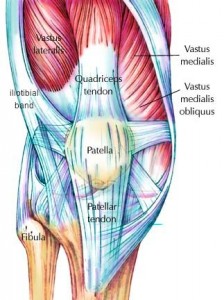Classic anatomical drawing. Notice how the tendons directly connect a muscle to a bone.
Compare that with this next anatomical drawing, which shows more details of how the fibers of the fascia interact.
In this drawing, it is harder to say what the final effect of a muscle contraction will be. The muscle will pull on the fascia, but the fibers of the fascia interact with each other in a complex mesh and seem to attach to many locations. This is complicated by our bodies process of laying down collagen tissue which will “glue” neighboring muscles and ligaments together if they are not moved frequently enough (see My post on Fascia, Collagen, Motion, and Bodywork). To see the complexity, look at the fibers labeled “iliotibial band.” If you pulled on the top of this, what would happen? It splits into multiple branches attaching to various other structures that are also themselves affected by various other muscles. Pay attention to how most of the fascia in the knee connect to the patella (the knee cap). The patella is not anchored in place, rather it is “floating” in a web of tension from all the fascia connections, thus all muscles that connect to the patella directly impact the tension and flow of forces from all the other muscles and fascia which connect to the patella — i.e. it all connects!
Now, let us take this one level further and look at the following picture of the knee of a human cadaver. The Body Worlds Exhibit where I first saw this is an AMAZING experience and opened my mind to a lot of understanding by being able to see the full structure of the body in 3D.
'생리학' 카테고리의 다른 글
| 아유르베다 (0) | 2013.01.19 |
|---|---|
| 요가 스타일이나 요가 경로 (0) | 2012.09.26 |
| 빠른 호흡 (0) | 2012.09.26 |
| 요가호흡(깊은호흡) (0) | 2012.09.26 |
| Pranayama - 호흡의 과학 - 1 (0) | 2012.09.26 |

